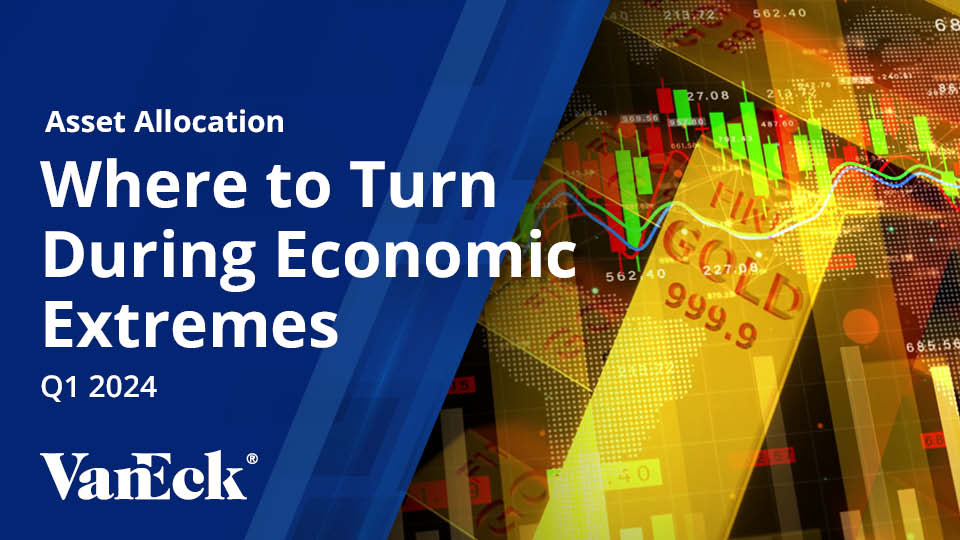Inflation Allocation ETF (RAAX): Question & Answer
September 14, 2022
Read Time 6 MIN
Given that investors last faced inflation risk in the early-to-mid 2000s and not at this magnitude since the 1970s, few may have experienced the potentially destructive impact high inflation can inflict on a portfolio. In fact, investor allocations are likely reflective of a much different macroeconomic environment than exists today. Return expectations for both stocks and bonds, and the traditional role they play in a portfolio, may not continue going forward as inflation continues to linger.
Allocating to real assets is one way that investors can position their portfolios for a prolonged inflationary environment, as real assets have historically performed well in prior periods of high inflation. This blog is intended to answer frequently asked questions about real asset investing and more specifically, the VanEck Inflation Allocation ETF (RAAX®). RAAX seeks to be a one-stop, diversified and risk managed solution to access the inflation protection of real assets.
To get a better understanding of inflation and its impact on markets and portfolios, please view our latest insights, including blogs, videos, and webinars.
- What are real assets and how do they provide inflation protection in a portfolio?
- What asset classes does RAAX invest in?
- How does RAAX determine its exposures?
- Since RAAX invests in commodities, does it issue K-1s for tax reporting?
- How does RAAX select its underlying ETFs?
- How has RAAX performed in the current high inflationary period?
- Is Gold’s recent underperformance likely to continue?
- How does RAAX fit into a portfolio during weak growth and/or periods of lower inflation?
- How can investors buy VanEck ETFs?
What are real assets and how do they provide inflation protection in a portfolio?
Real assets typically including commodities, natural resource equities, gold, MLPs, REITs and infrastructure. An allocation to real assets can serve three key roles in a portfolio:
- Hedge to inflationary pressure.
- Exposure to global growth.
- Portfolio diversifier.
Real assets have historically performed well in periods of high inflation, including during the 1970s and the last bout of inflation in the mid-2000s. Across both these periods, real assets, in general, outperformed traditional asset classes such as stocks and bonds.
Average 12M Real Return when CPI is at or Above Certain Levels (1969-1981)
Source: Bloomberg. "Comodities" = Bloomber Commodity Index; "Gold" = Gold spot price in U.S. dollars per troy ounce; "Equities" = S&P Index; "Fixed Income" = U.S. Generic Government 10-Year Treasury yield. Please see important disclosurs and index definitions at the end of presentation. Past performnace is not indicative of future results.
Average 12M Real Return when CPI is at or Above Certain Levels (2003-2007)
Source: Bloomberg. Past Performance is no guarantee of future results. Please see important disclaimers and index definitions in Disclosure.
What asset classes does RAAX invest in?
RAAX’s investable universe includes most of the individual asset classes commonly accepted as real assets. The Fund primarily allocates to exchange-traded products (“ETPs”) that provide exposure to inflation fighting real assets including resource assets: commodities, natural resource equities; income assets: REITs, Infrastructure, MLPs; and financial assets: gold and gold stocks.
RAAX’s three primary groups are based on the type of asset and the benefit it potentially offers investors.
How does RAAX determine its exposures?
To allocate to these real asset classes, RAAX utilizes a rules-based, quantitative investment process to determine allocations. This process is overseen by VanEck’s Multi-Asset Solutions (MAS) team and led by Portfolio Manager, David Schassler. The Team comprised of members with mathematics and computer science backgrounds acts as the firm’s internal resource for quantitative research and risk measurement.
Specific metrics related to each individual asset classes’ return and risk characteristics are analyzed. With these metrics as inputs, a quantitative optimization process is used as a guide to determine the asset class weightings. This quantitative approach allows the portfolio to dynamically adapt exposures to market conditions while providing diversification and a consistent risk profile over time. Portfolio exposures are monitored on a daily basis.
Visit the fund page for the fact sheet, holdings, performance and more.
Since RAAX invests in commodities, does it issue K-1s for tax reporting?
Unlike some other strategies which provide access to commodities, RAAX is offered in a traditional, 40 act ETF structure. Accordingly, there is no K-1 tax reporting and investors will receive manageable 1099 forms at year end.
How does RAAX select its underlying ETFs?
Exposures, liquidity and costs are key criterion used to select the underlying ETFs. RAAX may use both external and internal, or those offered by VanEck, ETFs. Fees for underlying VanEck ETFs are waived and are not included in RAAX’s overall expense ratio.
How has RAAX performed in the current high inflationary period?
The rate of inflation has been rising and we expect that inflation will remain elevated for some time. In the current inflationary period, RAAX’s exposure to inflation-fighting real assets has responded and provided the expected inflation hedge within a portfolio.
Please visit VanEck Inflation Allocation ETF (RAAX®) for standardized performance as of the most recent month end.
VanEck Inflation Allocation ETF (Ticker: RAAX) Performance vs CPI YoY Change
Source: Bloomberg. As of 06/30/2022. RAAX NAV performance. Past performance is not a guarantee of future results.
Is Gold’s recent underperformance likely to continue?
Gold has lagged other real assets due, primarily, to the market’s general view that high inflation may not persist coupled with a strong U.S. dollar relative to other currencies.
The charts below splits the last two high inflationary regimes into halves. Historically, gold has outperformed in the second half of the inflation cycle. The inflection point is tied to changing investor psychology with the recognition that inflation has become a problem with detrimental impact on daily life.
1st Half of the 1970s High Inflation Regime
1st Half of the Mid-2000s High Inflation Regime
Source: Bloomberg. Past performance is not a guarantee of future results.
Source: Bloomberg. Please see important disclaimers and index definitions in Disclosure. Past performance is not a guarantee of future results.
2nd Half of the 1970s High Inflation Regime
2nd Half of the Mid-2000s High Inflation Regime
Source: Bloomberg. Please see important disclaimers and index definitions in Disclosure. Past performance is not a guarantee of future results.
How does RAAX fit into a portfolio during weak growth and/or periods of lower inflation?
During periods of high inflation, such as now, RAAX has the ability to favor real assets that benefit from inflation, such as commodities and natural resource equities. Alternatively, during periods of low inflation, RAAX has the ability to concentrate its holdings in real assets that have historically performed well in that environment, such as REITS and infrastructure.
More recently, concerns regarding a potential recession or stagflationary environment have become more prominent among investors. Historically, based on data from the 1970s, in periods when GDP declined and inflation remained elevated above normal levels, real assets still outperformed stocks.
Finally, real assets may also offer diversification benefits and exposure to global growth within a portfolio regardless of the level of inflation.
Average Quarterly Returns When GDP is Negative and CPI is Above Average
(September 1969 - September 1982)
Please see important disclaimers and index definitions in Disclosure.
How can investors buy VanEck ETFs?
To receive more Asset Allocation insights, sign up in our subscription center.
Related Topics
Related Insights
February 28, 2024
February 22, 2024
December 19, 2023
DISCLOSURES
CPI – US CPI Urban Consumers YoY NSA Index measures US consumer prices (CPI) as a measure of prices paid by consumers for a market basket of consumer goods and services. The yearly (or monthly) growth rates represent the inflation rate.
Commodities – Bloomberg Commodity Index is made up of 23 exchange-traded futures on physical commodities, representing 21 commodities, which are weighted to account for economic significance and market liquidity.
Gold – Gold spot price in U.S. dollars per troy ounce.
Equities – S&P 500 Index is a free-float weighted measurement stock market index of 500 of the largest companies listed on stock exchanges in the United States. Prior to January 4, 1988 the index is Total Return, and after it is Price Return.
Fixed Income – U.S. Generic Government 10-Year Treasury yield assuming a constant 7 year duration to approximate a generic U.S. Government Treasury return.
Natural Resources – S&P Global Natural Resources Index includes 90 of the largest publicly-traded companies in natural resources and commodities businesses that meet specific investability requirements, offering investors diversified and investable equity exposure across 3 primary commodity-related sectors: agribusiness, energy, and metals & mining.
Infrastructure – S&P Global Infrastructure Index is designed to track 75 companies from around the world chosen to represent the listed infrastructure industry while maintaining liquidity and tradability. To create diversified exposure, the index includes three distinct infrastructure clusters: energy, transportation, and utilities.
REITS – Dow Jones Equity REIT Index is designed to measure all publicly traded real estate investment trusts in the Dow Jones U.S. stock universe classified as equity REITs according to the S&P Dow Jones Indices REIT Industry Classification Hierarchy. These companies are REITs that primarily own and operate income-producing real estate.
The S&P 500 Index is a product of S&P Dow Jones Indices LLC and/or its affiliates and has been licensed for use by Van Eck Associates Corporation. Copyright © 2021 S&P Dow Jones Indices LLC, a division of S&P Global, Inc., and/or its affiliates. All rights reserved. Redistribution or reproduction in whole or in part are prohibited without written permission of S&P Dow Jones Indices LLC. For more information on any of S&P Dow Jones Indices LLC’s indices please visit www.spglobal.com/spdji/en/. S&P® is a registered trademark of S&P Global and Dow Jones® is a registered trademark of Dow Jones Trademark Holdings LLC. Neither S&P Dow Jones Indices LLC, Dow Jones Trademark Holdings LLC, their affiliates nor their third party licensors make any representation or warranty, express or implied, as to the ability of any index to accurately represent the asset class or market sector that it purports to represent and neither S&P Dow Jones Indices LLC, Dow Jones Trademark Holdings LLC, their affiliates nor their third party licensors shall have any liability for any errors, omissions, or interruptions of any index or the data included therein.
This is not an offer to buy or sell, or a recommendation to buy or sell any of the securities/financial instruments mentioned herein. The information presented does not involve the rendering of personalized investment, financial, legal, or tax advice. Certain statements contained herein may constitute projections, forecasts and other forward looking statements, which do not reflect actual results, are valid as of the date of this communication and subject to change without notice. Information provided by third party sources are believed to be reliable and have not been independently verified for accuracy or completeness and cannot be guaranteed. VanEck does not guarantee the accuracy of third-party data. The information herein represents the opinion of the author(s), but not necessarily those of VanEck.
An investment in the VanEck Inflation Allocation ETF may be subject to risks which include, among others, in fund of funds risk which may subject the Fund to investing in commodities, gold, natural resources companies, MLPs, real estate sector, infrastructure, equities securities, small- and medium-capitalization companies, foreign securities, emerging market issuers, foreign currency, credit, interest rate, call and concentration risks, derivatives, cryptocurrency, cryptocurrency tax, all of which may adversely affect the Fund. The Fund may also be subject to affiliated fund, U.S. Treasury Bills, subsidiary investment, commodity regulatory (with respect to investments in the Subsidiary), tax (with respect to investments in the Subsidiary), risks of ETPs, liquidity, gap, cash transactions, high portfolio turnover, model and data, management, operational, authorized participant concentration, no guarantee of active trading market, trading issues, market, fund shares trading, premium/discount and liquidity of fund shares, and non-diversified risks. . Foreign investments are subject to risks, which include changes in economic and political conditions, foreign currency fluctuations, changes in foreign regulations, and changes in currency exchange rates which may negatively impact the Fund's returns. Small- and medium-capitalization companies may be subject to elevated risks.
There may be risks posed by the lack of regulation for cryptocurrencies and any future regulatory developments could affect the viability and expansion of the use of cryptocurrencies. Investors should conduct extensive research before investing in cryptocurrencies.
Information provided by Van Eck is not intended to be, nor should it be construed as financial, tax or legal advice. It is not a recommendation to buy or sell an interest in cryptocurrencies.
Investing involves substantial risk and high volatility, including possible loss of principal. An investor should consider the investment objective, risks, charges and expenses of the Fund carefully before investing. To obtain a prospectus and summary prospectus, which contains this and other information, call 800.826.2333 or visit ETF and Mutual Fund Manager. Please read the prospectus and summary prospectus carefully before investing.
Van Eck Securities Corporation, Distributor, a wholly owned subsidiary of Van Eck Associates Corporation.
666 Third Avenue | New York, NY 10017
© 2022 VanEck. VanEck®, VanEck Access the opportunities®, and the stylized VanEck design® are trademarks of Van Eck Associates Corporation.
Related Funds
DISCLOSURES
CPI – US CPI Urban Consumers YoY NSA Index measures US consumer prices (CPI) as a measure of prices paid by consumers for a market basket of consumer goods and services. The yearly (or monthly) growth rates represent the inflation rate.
Commodities – Bloomberg Commodity Index is made up of 23 exchange-traded futures on physical commodities, representing 21 commodities, which are weighted to account for economic significance and market liquidity.
Gold – Gold spot price in U.S. dollars per troy ounce.
Equities – S&P 500 Index is a free-float weighted measurement stock market index of 500 of the largest companies listed on stock exchanges in the United States. Prior to January 4, 1988 the index is Total Return, and after it is Price Return.
Fixed Income – U.S. Generic Government 10-Year Treasury yield assuming a constant 7 year duration to approximate a generic U.S. Government Treasury return.
Natural Resources – S&P Global Natural Resources Index includes 90 of the largest publicly-traded companies in natural resources and commodities businesses that meet specific investability requirements, offering investors diversified and investable equity exposure across 3 primary commodity-related sectors: agribusiness, energy, and metals & mining.
Infrastructure – S&P Global Infrastructure Index is designed to track 75 companies from around the world chosen to represent the listed infrastructure industry while maintaining liquidity and tradability. To create diversified exposure, the index includes three distinct infrastructure clusters: energy, transportation, and utilities.
REITS – Dow Jones Equity REIT Index is designed to measure all publicly traded real estate investment trusts in the Dow Jones U.S. stock universe classified as equity REITs according to the S&P Dow Jones Indices REIT Industry Classification Hierarchy. These companies are REITs that primarily own and operate income-producing real estate.
The S&P 500 Index is a product of S&P Dow Jones Indices LLC and/or its affiliates and has been licensed for use by Van Eck Associates Corporation. Copyright © 2021 S&P Dow Jones Indices LLC, a division of S&P Global, Inc., and/or its affiliates. All rights reserved. Redistribution or reproduction in whole or in part are prohibited without written permission of S&P Dow Jones Indices LLC. For more information on any of S&P Dow Jones Indices LLC’s indices please visit www.spglobal.com/spdji/en/. S&P® is a registered trademark of S&P Global and Dow Jones® is a registered trademark of Dow Jones Trademark Holdings LLC. Neither S&P Dow Jones Indices LLC, Dow Jones Trademark Holdings LLC, their affiliates nor their third party licensors make any representation or warranty, express or implied, as to the ability of any index to accurately represent the asset class or market sector that it purports to represent and neither S&P Dow Jones Indices LLC, Dow Jones Trademark Holdings LLC, their affiliates nor their third party licensors shall have any liability for any errors, omissions, or interruptions of any index or the data included therein.
This is not an offer to buy or sell, or a recommendation to buy or sell any of the securities/financial instruments mentioned herein. The information presented does not involve the rendering of personalized investment, financial, legal, or tax advice. Certain statements contained herein may constitute projections, forecasts and other forward looking statements, which do not reflect actual results, are valid as of the date of this communication and subject to change without notice. Information provided by third party sources are believed to be reliable and have not been independently verified for accuracy or completeness and cannot be guaranteed. VanEck does not guarantee the accuracy of third-party data. The information herein represents the opinion of the author(s), but not necessarily those of VanEck.
An investment in the VanEck Inflation Allocation ETF may be subject to risks which include, among others, in fund of funds risk which may subject the Fund to investing in commodities, gold, natural resources companies, MLPs, real estate sector, infrastructure, equities securities, small- and medium-capitalization companies, foreign securities, emerging market issuers, foreign currency, credit, interest rate, call and concentration risks, derivatives, cryptocurrency, cryptocurrency tax, all of which may adversely affect the Fund. The Fund may also be subject to affiliated fund, U.S. Treasury Bills, subsidiary investment, commodity regulatory (with respect to investments in the Subsidiary), tax (with respect to investments in the Subsidiary), risks of ETPs, liquidity, gap, cash transactions, high portfolio turnover, model and data, management, operational, authorized participant concentration, no guarantee of active trading market, trading issues, market, fund shares trading, premium/discount and liquidity of fund shares, and non-diversified risks. . Foreign investments are subject to risks, which include changes in economic and political conditions, foreign currency fluctuations, changes in foreign regulations, and changes in currency exchange rates which may negatively impact the Fund's returns. Small- and medium-capitalization companies may be subject to elevated risks.
There may be risks posed by the lack of regulation for cryptocurrencies and any future regulatory developments could affect the viability and expansion of the use of cryptocurrencies. Investors should conduct extensive research before investing in cryptocurrencies.
Information provided by Van Eck is not intended to be, nor should it be construed as financial, tax or legal advice. It is not a recommendation to buy or sell an interest in cryptocurrencies.
Investing involves substantial risk and high volatility, including possible loss of principal. An investor should consider the investment objective, risks, charges and expenses of the Fund carefully before investing. To obtain a prospectus and summary prospectus, which contains this and other information, call 800.826.2333 or visit ETF and Mutual Fund Manager. Please read the prospectus and summary prospectus carefully before investing.
Van Eck Securities Corporation, Distributor, a wholly owned subsidiary of Van Eck Associates Corporation.
666 Third Avenue | New York, NY 10017
© 2022 VanEck. VanEck®, VanEck Access the opportunities®, and the stylized VanEck design® are trademarks of Van Eck Associates Corporation.



